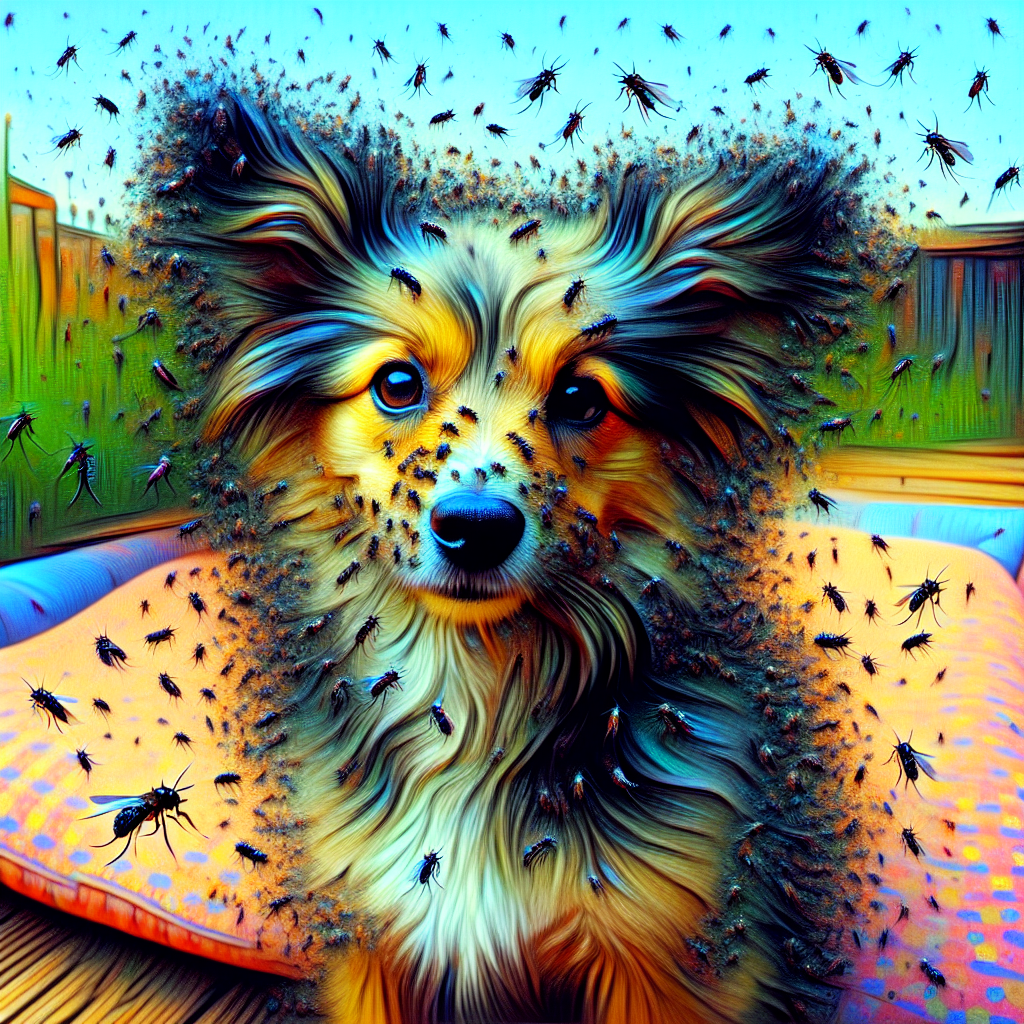Understanding the Flea Problem in Your Home

Fleas in the house? It’s like a bad horror movie you can’t escape from. These tiny pests don’t just make your dog scratch; they turn your home into a battlefield. I’ve been in the pet industry for two decades, and trust me, I’ve seen my fair share of flea problems. Once these critters find their way into your house, they multiply faster than rabbits. Understanding the flea problem is the first step toward figuring out the best way to clean fleas from your house.
Fleas thrive in warm, humid environments. They’re not picky; they love your carpets, furniture, and even the cracks in your floor. Your dog or cat is just their ticket inside. Once they’re in, they lay eggs, which fall off your pet and scatter everywhere. Before you know it, you’ve got a full-blown flea infestation. It’s not just about the itching; fleas can transmit nasty diseases to pets and humans alike. So, it’s crucial to tackle the problem head-on.
Identifying Signs of Fleas in Your House
So, how do you know if you’ve got a flea infestation? Look out for flea infestation signs. Your pet might be scratching like it’s the end of the world. Check for flea dirt, which looks like tiny black specks. A flea comb can help you find these signs on your pet. But fleas are sneaky. They love hiding spots like the cracks in floors, behind furniture, and in carpets.
If you’re feeling adventurous, wear white socks and walk around your house. Fleas are easy to spot against a light background. You might also notice red, itchy bites on your ankles. These are telltale signs that fleas have made themselves at home. The sooner you catch these signs, the better. Once you confirm their presence, it’s time to take action.
Essential Tools for Flea Detection
Alright, you’ve spotted the signs. Now what? Time to get your hands dirty with some flea detection tools. Trust me, it’s not as bad as it sounds. Start with a fine-toothed flea comb. It’s your best friend when it comes to finding fleas on your pet. Run it through their fur, especially around the neck and tail. If you catch any fleas, dip the comb in soapy water to kill them.
Next, let’s talk about vacuuming for fleas. Your regular vacuum cleaner becomes an essential tool in this battle. Fleas hate a good vacuuming. Go over your carpets, rugs, furniture, and pet bedding. Make sure to empty the vacuum bag outside. Don’t forget to wash your pet’s bedding in hot water. If you’re tech-savvy, consider getting a flea trap. These little gadgets use light to lure fleas and trap them. They’re a great addition to your flea-fighting arsenal.
Daily Cleaning Routines to Combat Fleas
Once you’ve armed yourself with the right tools, it’s time to dive into your daily flea cleaning routine. This ain’t a one-and-done deal. You gotta be consistent. Start with vacuuming every single day. I know, it sounds like a lot, but trust me, it works. Fleas and their eggs get sucked up, reducing their numbers significantly.
Don’t forget to wash your pet’s bedding and your own. Hot water is your ally here. Fleas can’t survive high temperatures, so crank up the heat. If your pet loves the couch or your bed, throw those covers in the wash too.
Here’s a pro tip: use a steam cleaner on your carpets and upholstery. The heat from the steam will kill fleas and their eggs. It’s like a spa day for your furniture, minus the relaxing part. Stick to this routine, and you’ll see those pesky fleas start to disappear.
Effective Flea Control Strategies
Now that you’ve got a cleaning routine down, let’s talk about home flea control methods. Prevention is better than cure, and that’s so true when it comes to fleas. Start with flea prevention strategies like using flea medication on your pets. There are oral and topical options, and your vet can recommend the best one for your furry friend.
But it’s not just about treating your pet. You need to treat your home too. Consider using flea sprays or powders designed for household use. They can help in killing fleas in those hard-to-reach places. Just make sure they’re pet-safe.
Another effective strategy is diatomaceous earth. It’s a natural powder that dehydrates and kills fleas. Sprinkle it on your carpets and let it sit for a couple of hours before vacuuming. It’s non-toxic and safe for pets, but be careful not to inhale it.
Remember, consistency is key. Stick to these strategies, and you’ll find the best way to clean fleas from your house. Hang in there. It might seem overwhelming, but you’re not alone. Many pet owners have been in your shoes and come out victorious. You’ve got this! Thanks for sticking with me through this flea-fighting journey. Here’s to a flea-free home and happy pets!
Vacuuming: Your First Line of Defense
Ah, vacuuming! It’s not just about keeping your floors clean anymore. When it comes to the best way to clean fleas from your house, vacuuming is your first line of defense. Trust me, I’ve been around pets for over two decades, and this is one piece of advice you won’t want to skip. Now, we’re not talking about your regular once-a-week routine. Nope, this is a daily commitment, at least until you see those pesky fleas start to disappear. Vacuuming to remove fleas is like a mini workout session for your home. You’re not just sucking up dirt; you’re targeting flea eggs and larvae that could be nestled deep in your carpets and furniture.
You might be wondering, “Why daily?” Well, fleas breed like it’s going out of style. A single flea can lay up to 50 eggs a day. So, while your pet might be the original host, those eggs can roll off and settle into your carpet fibers, waiting to hatch. Grab your vacuum cleaner and get to work. Focus on areas where your pet likes to hang out. Don’t forget those sneaky corners and under the furniture. It’s free, apart from the electricity and about 15 minutes of your day. It’s worth every second.
Washing Fabrics: More Than Just a Laundry Day
Next up on the flea eviction plan is washing fabrics. Fleas love to hide in soft, cozy places. So, grab anything your pet has snuggled into—bedding, throws, even your pillowcases. Washing pet bedding for fleas isn’t just a chore; it’s a necessity. Toss these items into your washing machine on the hottest setting it can handle. Heat is your ally here. It not only cleans but also kills any flea eggs or larvae that might be lurking.
I remember a time when a friend of mine was battling a flea infestation. She thought washing on a regular cycle would do the trick. Nope. It wasn’t until she cranked up the temperature that she saw real results. So, don’t skimp on the heat. And if you have any fabrics that can’t be washed in hot water, consider taking them to a dry cleaner. You want those fleas gone for good.
Natural Remedies: Do They Really Work?
Let’s chat about natural remedies. There’s a lot of buzz about them, but do they really work? Over the years, I’ve seen people try everything from lavender to vinegar, hoping for a miracle. Natural flea remedies effectiveness varies, and it’s crucial to do your homework before diving in. Some oils and plants can repel fleas, but others might not be as effective as you’d hope.
Lavender, for example, is a popular choice, but it’s not a one-size-fits-all solution. You can try creating a lavender spray to spritz around your home, but remember, it’s more of a complementary approach rather than a standalone solution. And a word of caution: some essential oils can be harmful to pets. Always do a spot test and consult with a vet if you’re unsure. Eco-friendly flea control methods are great, but safety comes first.
Chemical Treatments: When to Consider Them
Okay, so sometimes natural just doesn’t cut it. Chemical treatments can be intimidating, but when things get out of hand, they might be necessary. I’ve had clients who were at their wits’ end, and chemical flea treatments at home were their saving grace. It’s important to read labels and perhaps have a chat with your vet to ensure you’re using them safely and effectively.
These treatments can be quite potent, so use them with care. They’re designed to kill fleas at various life stages, and sometimes, it’s the only way to reclaim your home from these relentless invaders. Think of it as calling in the cavalry. It might not be your first choice, but it’s a powerful tool when the infestation is severe. Just remember, these treatments are a temporary fix. You’ll still need to focus on prevention to keep those fleas from coming back.
Long-Term Prevention: Keeping Fleas Away for Good
Speaking of prevention, let’s wrap up with some long-term flea prevention strategies. The best way to clean fleas from house isn’t just about getting rid of them; it’s about keeping them away for good. Regular treatments for your pets, keeping your yard tidy, and considering flea-repelling plants are all part of this strategy. Prevention is much easier than dealing with an infestation.
Ever heard the saying, “An ounce of prevention is worth a pound of cure”? It couldn’t be truer when it comes to fleas. Investing in a good flea prevention product for your pet can save you a lot of headaches down the road. And don’t forget about your home environment. Fleas love dark, moist areas, so keeping your home bright and dry can help. Best practices for flea prevention include regular vacuuming, washing, and perhaps even a little landscaping to keep your outdoor spaces less inviting to these pests.
So, there you have it. With a bit of elbow grease and some strategic planning, you can turn your home into a flea-free zone. Thanks for sticking with me through this flea saga. Here’s to a flea-free home and happy pets! You got this!
Deep Cleaning Your Home: Essential Steps to Eradicate Fleas
Ah, the dreaded flea infestation. It’s like an unwelcome party that never ends. But, let’s face it, the best way to clean fleas from a house isn’t just a quick sweep. It’s a full-on deep cleaning marathon. Picture this: you’re armed with a vacuum and determination, ready to tackle every nook and cranny. Fleas love hiding in carpets, upholstery, and even those sneaky baseboards. So, roll up your sleeves and get into some serious deep cleaning for fleas.
Start with a powerful vacuum, one that can suck up not just dirt but those tiny flea eggs, too. Focus on areas where your pets love to hang out. Don’t skip the furniture—fleas are sneaky little critters that love to hide. After vacuuming, wash all pet bedding and your linens in hot water. It’s a bit of a chore, but the satisfaction of knowing you’re eradicating those itchy intruders is worth every minute. Trust me, I’ve been there, done that.
Now, let’s talk baseboards. Fleas love to hide in the tiniest cracks. Use a high-pressure steam cleaner if you’ve got one. The heat will help kill off any lingering eggs or larvae. And speaking of heat, you might want to consider using a dryer for pet beds and soft toys. The heat from the dryer can eliminate any remaining flea life stages. It’s a battle, but one you can definitely win with a bit of elbow grease.
Natural Remedies: Can They Really Help With Fleas?
Natural remedies for fleas—sounds promising, right? Who wouldn’t want a greener solution? But, here’s the rub: the effectiveness of natural flea remedies can vary. I’ve heard tales of essential oils and vinegar, and while they can help, they’re not a magic bullet. Before you dive into the world of DIY natural flea remedies, do your homework. Essential oils, for example, can be harmful to pets if not used correctly.
Now, I know some of you might be thinking about eco-friendly flea control. It’s an appealing idea, especially given the impact of chemicals on our planet. But, remember, not all that glitters is gold. Some natural remedies might help repel fleas but won’t necessarily eliminate an infestation. For instance, diatomaceous earth—a natural powder—can be sprinkled on carpets. It works by dehydrating fleas. But, it’s not a stand-alone solution. Pair it with regular cleaning and vet-approved treatments for the best results.
Natural remedies can be part of your arsenal, but they shouldn’t be your only line of defense. Think of them as a supplement to more proven methods. If you’re looking for a more nature-friendly approach, consult your vet. They can suggest treatments that are effective yet easy on Mother Nature.
Professional Pest Control: When to Call in the Experts
Sometimes, despite your best efforts, the flea situation gets out of hand. It’s like trying to bail water out of a sinking ship with a spoon. That’s when you need to call in the cavalry: professional flea extermination. These folks have the tools, knowledge, and experience to tackle even the worst infestations.
You might be wondering, “When should I give the pros a call?” If you’ve tried deep cleaning, natural remedies, and over-the-counter treatments with little success, it’s time. Professional pest control can save you time and sanity. They can assess the situation and create a tailored plan to rid your home of fleas. Plus, they often offer guarantees, so if the fleas make a comeback, they’ve got your back.
Now, don’t think of this as a failure on your part. Fleas are crafty little pests. Sometimes, you need a bit of extra muscle to get the job done. And hey, it’s worth it to see your pets comfortable and your home flea-free. Remember, investing in professional help can save you money in the long run by preventing re-infestations.
Long-Term Prevention: Keeping Your Home and Pets Flea-Free
Prevention is the name of the game, folks. It’s all about creating an environment where fleas don’t even want to crash. Regular cleaning and vet-recommended flea preventatives are your secret weapons. You see, the best way to clean fleas from a house is to stop them from getting in at all.
Start with flea prevention tips for your home. Regular vacuuming, washing pet bedding, and keeping your yard tidy can go a long way. Fleas thrive in humid, shady areas, so keep your lawn trimmed and clear any debris. It’s all about making your home as unappealing to fleas as possible.
And let’s not forget about how to maintain flea-free pets. Regular grooming and vet visits are crucial. Your vet can recommend the best flea preventatives tailored to your pet’s needs. These treatments are often applied monthly and can protect your pets from fleas and ticks.
But, don’t stop there. Long-term flea prevention strategies include feeding your pets a balanced diet and maintaining their overall health. A healthy pet is less attractive to fleas. And remember, prevention is easier and cheaper than dealing with a flea infestation.
Final Thoughts: Embrace a Flea-Free Life
So, there you have it! We’ve journeyed through the ups and downs of flea control together. It’s not always easy, but with the right steps, a flea-free home is within reach. Thanks for sticking with me through this flea-fighting adventure. You’ve got the tools and knowledge to keep those itchy intruders at bay.
Remember, whether it’s deep cleaning, trying out natural remedies, or calling in the pros, you’re not alone. There are plenty of resources and people ready to help. Keep up the great work, and here’s to a life without those pesky fleas. You’ve got this!
Quick Takeaways:
Alright folks, dealing with fleas in your house isn’t just a one-time event; it’s like running a marathon. First off, vacuuming for fleas should be your new daily habit. We’re talking about a serious daily flea cleaning routine here. Every corner, every crevice, because fleas love hiding spots like those. It’s free, just a bit of your time. If you find signs of flea infestation, like flea dirt or flea bites on your pets, it’s time to spring into action.
Next up, washing pet bedding for fleas is a must. Throw all that pet stuff in the wash on the hottest setting. Consider it an evacuation plan for fleas. Also, don’t forget to wash any throws or blankets your pets might have snuggled into. That’s another step in the home flea control methods playbook.
Now, let’s talk about the effectiveness of natural flea remedies. They sound great, but be careful. Not all are safe for pets. Lavender, vinegar, and such might help, but do your homework first. And if things get wild, chemical flea treatments at home could be your best friend. They can be intimidating, but sometimes they’re necessary to reclaim your space.
But hey, prevention is key for long-term flea-free living. Regular treatments and keeping your yard tidy are solid flea prevention strategies. You might even find that eco-friendly flea control methods, like flea-repelling plants, can be part of your best practices for flea prevention. Keep at it, and soon enough, your home will be a no-flea zone!
FAQs:
1.
What are the signs of a flea infestation in my house?
Flea infestation signs include noticing your pets scratching more than usual, spotting tiny black specks (flea dirt) on their skin, or seeing fleas themselves. If you notice these, it’s time to start your daily flea cleaning routine and consider using flea detection tools.
2.
What’s the best way to clean fleas from the house?
The best way to clean fleas from a house involves a multi-step approach. Start with vacuuming to remove fleas from all surfaces and wash pet bedding frequently. Use a combination of natural flea remedies, if safe, and chemical treatments if needed. Regularly inspect and treat your pets, and keep your home tidy to prevent fleas from returning.
3.
How effective are natural flea remedies?
Natural flea remedies can be effective, but their success can vary. Some pet owners find that essential oils or vinegar help, but these remedies need careful research to ensure they’re safe for pets. Always test in small areas and consult with a vet when in doubt.
4.
Is vacuuming for fleas alone sufficient to eliminate them?
Vacuuming for fleas is a critical step and should be done daily, but it’s not enough on its own. It needs to be part of a broader strategy that includes washing pet bedding, using flea treatments on pets, and possibly applying chemical flea treatments at home for severe infestations.
5.
What long-term flea prevention strategies can I implement?
Long-term flea prevention strategies include regular use of vet-recommended flea treatments, keeping your yard and home clean, and considering eco-friendly flea control methods like flea-repelling plants. Regular visits to the vet for flea checks are also a good practice.
Conclusion:
In the battle against fleas, the best way to clean fleas from your house is a blend of consistent effort and smart prevention. Start with a solid cleaning regime: vacuum daily, wash everything your pets touch, and use flea treatments as needed. Remember, natural remedies can help, but do your homework. And if things get really tricky, don’t hesitate to bring out the chemical treatments, with your vet’s guidance, of course.
The key to keeping fleas at bay in the long run is prevention. Make flea checks part of your regular routine, and keep your home and yard tidy. Think of it as a continuous journey rather than a destination. With the right strategies in place, you can reclaim your home from these pesky intruders. Thanks for sticking with me through this journey. Here’s to a future where fleas are just a memory. Keep at it, and your home will be a flea-free zone in no time!
References:
1. [Healthline: How to Get Rid of Fleas](https://www.healthline.com/health/healthy-home-guide/how-to-get-rid-of-fleas)
2. [The Spruce: Removing Fleas in the Home](https://www.thespruce.com/removing-fleas-in-the-home-1900755)
3. [Good Housekeeping: How to Get Rid of Fleas](https://www.goodhousekeeping.com/home/cleaning/a39838995/how-to-get-rid-of-fleas/)
4. [Super Cleaning Service Louisville: How to Deep Clean House with Fleas](https://supercleaningservicelouisville.com/how-to-deep-clean-house-with-fleas/)
Our solution eradicates fleas on contact without harmful chemicals, ensuring a safe environment for your pets and family. Easy to use and highly effective, SayByeBugs helps you maintain a flea-free home. Learn more and order today at SayByeBugs.com
Our solution eradicates fleas on contact without harmful chemicals, ensuring a safe environment for your pets and family. Easy to use and highly effective, SayByeBugs helps you maintain a flea-free home. Learn more and order today at SayByeBugs.com








